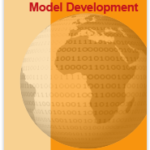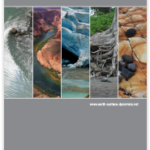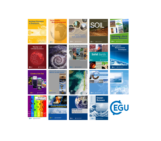
Each month we feature specific Divisions of EGU and during the monthly GeoRoundup we will be putting the journals that publish science from those Divisions at the top of the Highlights roundup. For November, the Divisions we are featuring are: Stratigraphy, Sedimentology and Palaeontology (SSP) and Geomorphology (GM). They are served by the journals: Geoscientific Model Development (GMD), Earth Surface Dynamics (ESurf) and Solid Earth (SE).
Featured highlights
 Impact of horizontal resolution on global ocean–sea ice model simulationsbased on the experimental protocols of the Ocean Model IntercomparisonProject phase 2 (OMIP-2) – 3 November 2020
Impact of horizontal resolution on global ocean–sea ice model simulationsbased on the experimental protocols of the Ocean Model IntercomparisonProject phase 2 (OMIP-2) – 3 November 2020
This paper presents global comparisons of fundamental global climate variables from a suite of four pairs of matched low- and high-resolution ocean and sea ice simulations to assess the robustness of climate-relevant improvements in ocean simulations associated with moving from coarse (∼1°) to eddy-resolving (∼0.1°) horizontal resolutions. Despite significant improvements, greatly enhanced horizontal resolution does not deliver unambiguous bias reduction in all regions for all models.
The Making of the New European Wind Atlas – Part 2: Production and evaluation – 23 November 2020
This is the second of two papers that document the creation of the New European Wind Atlas (NEWA). The paper includes a detailed description of the technical and practical aspects that went into running the mesoscale simulations and the microscale downscaling for generating the climatology. A comprehensive evaluation of each component of the NEWA model chain is presented using observations from a large set of tall masts located all over Europe.
 Topographic controls on divide migration, stream capture, anddiversification in riverine life – 18 November 2020
Topographic controls on divide migration, stream capture, anddiversification in riverine life – 18 November 2020
Organisms evolve in ever-changing environments under complex process interactions. We applied a new software modelling tool to assess how changes in river course impact the evolution of riverine species. Models illustrate the climatically and tectonically forced landscape changes that can drive riverine biodiversity, especially where topographic relief is low. This research demonstrates that river course changes can contribute to the high riverine biodiversity found in real-world lowland basins.
Other highlights
Atmospheric Chemistry and Physics:
Absorption closure in highly aged biomass burning smoke – 3 November 2020
Global modeling of cloud water acidity, precipitation acidity, and acidinputs to ecosystems – 24 November 2020
Large contribution of organics to condensational growth and formation of cloud condensation nuclei (CCN) in the remote marine boundary layer – 27 November 2020
Atmospheric Measurement Techniques:
A technical description of the Balloon Lidar Experiment (BOLIDE) – 19 November 2020
Factors controlling plankton community production, export flux, and particulate matter stoichiometry in the coastal upwelling system off Peru – 10 November 2020
Reviews and syntheses: The mechanisms underlying carbon storage in soil – 25 November 2020
Climate change as an incentive for future human migration – 17 November 2020
Resolving multiple geological events using in situ Rb–Sr geochronology:implications for metallogenesis at Tropicana, Western Australia – 17 November 2020
Hydrology and Earth System Sciences (HESS)
Hydrology and water resources management in ancient India – 5 November 2020
Ionic aluminium concentrations exceed thresholds for aquatic health in Nova Scotian rivers, even during conditions of high dissolved organic carbon and low flow – 10 November 2020
Connecting flow–topography interactions, vorticity balance, baroclinicinstability and transport in the Southern Ocean: the case of an idealizedstorm track – 12 November 2020
Beaching patterns of plastic debris along the Indian Ocean rim – 26 November 2020
EGU Science in the News
A snapshot of recent English-speaking news coverage based on research published in EGU’s 19 open access journals:
- 3D-Printed Weather Stations: More Science for Less Money SciTechDaily
- Investigating the Major Factors of Wheat Production in India over the Past Four Decades CO2 Science
- Relook agri-subsidies to curb agri-pollution Financial Express
- Playing the Long Game: The Intersection of Climate Change Risk and Financial Regulation U.S. Securities and Exchange Commission speech
- Powerful Glacial Floods Heave Himalayan Boulders Eos
- Climate Scientists Debunk ‘Point of No Return’ Paper Everyone’s Freaking Out About Gizmodo.com


